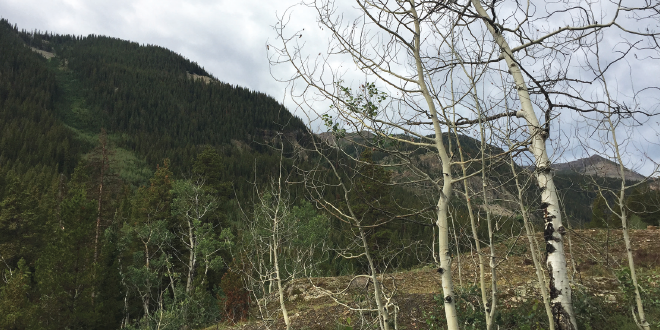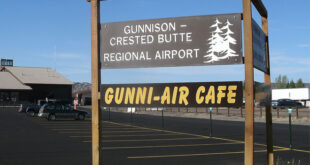Drought, frost, hail, leafhoppers
By Kendra Walker
Even as the aspen trees around Crested Butte begin transforming their leaves from green to gold over the next couple of weeks, groves in the area have also experienced transformations not quite as pleasant. Over the past several months, drought, weather and insects have negatively impacted aspen in the Gunnison Valley, resulting in leaf damage, stunted growth and dead trees.
“It’s been a brutal year for them,” said Suzanne Marchetti of the U.S. Forest Service. Marchetti works on forest health protection and has been tracking aspen damage this summer. “It’s been interesting to watch the aspen change and show all sorts of signs of damage,” she said.
In the Mill Creek and Cochetopa areas, Marchetti has observed hail storm damage, where large groups of leaves in the aspen canopies have been knocked down. She’s also observed late frost damage from earlier this summer, where the leaves become deformed, turn black and drop off.
Up in the Gothic area, Marchetti has seen a lot of browning leaves, which can be caused by drought stress or salts, like from magnesium chloride that is applied on the road. “The salt makes it harder for water to be taken by the aspen,” she said.
In the Ohio River Valley, Marchetti has noticed tortrix defoliators, which are moth larvae that eat the aspen leaves. Then as the trees work on refoliating, the hot summer temperatures and dry conditions cause the leaves to scorch, burning the edges of the leaves. “Then the heavy snow caused branches and whole trees to fall,” she added.
Another insect impacting aspen in the area is the leafhopper, which Rocky Mountain Biological Laboratory (RMBL) principal investigator David Inouye has observed this summer.
According to Inouye, there was a high population of the leafhoppers in June and July around the Gothic area, near Trail 401. “They go through their life cycle on the aspen leaves, feeding on aspen sap,” said Inouye. The insects excrete a sugary solution called honeydew while filtering the plants’ sap, he explained. “When there are a lot of the leafhoppers you can see glistening on the leaves of plants under the aspen trees, because of all the honeydew the leafhoppers produce. The amount of honeydew that we see down below tells us that there was a pretty high population this summer.”
Aspen trees are impacted when the female leafhopper makes oviposition slits in the branches to lay eggs, explained Inouye. This cuts some of the vessels and ends up killing the tree branch. “You can still see the effects of an outbreak/population explosion that happened in 1999, when susceptible [aspen] clones lost a lot of their lower branches,” he said.
Drought has also caused major negative impacts on aspen in the area, resulting in dead trees. Benjamin Blonder, an ecologist with the University of California at Berkeley Department of Environmental Science, Policy, and Management, has been monitoring aspen with RMBL since 2017, specifically looking at the effects of increased drought and changing climates on tree mortality. His program has a network of 500 different research locations in the area observing tree growth and death. This summer, he noted the biggest effects in the Slate River and East River drainages.
“What we’ve seen this year in particular is a lot more canopy thinning than in previous years,” said Blonder. “This is an early warning indicator of mortality that will occur in the next several years. I was quite surprised this year and very discouraged by the high levels we observed.”
However, Blonder said this is not unexpected, given the drought conditions the area has experienced over the past several years. He further explained when there’s a drought, it causes hydraulic damage in the trees and prevents water from getting pulled up through the trees. The water reduction inhibits the trees from being able to supply leaves and ultimately kills the trees. Blonder said that in a single drought event, an affected aspen tree’s lifespan will typically last three to seven years. But if you have a situation like in Crested Butte with multiple droughts occurring over multiple years, the trees will experience a further decline in their capacity to stay alive.
Blonder also explained that if a plant is suffering hydraulic damage, it’s also growing less than normal and has less capability in fighting off other impacts, such as weather, wildlife and insects. “So drought is the ultimate cause of killing the tree but it also has these downstream effects on the tree’s ability to defend itself.” Blonder said many of these dead trees are currently located along the Oh Be Joyful Trail.
Year over year, Blonder has observed trees deploying fewer leaves. However, he is researching how the trees are adapting on a larger timescale based on new growth replacing the dying trees, and how the new trees use water and invest in their leaves and how large they grow. “Some of those aspects are inheritable and the genotypes that are surviving are different from the ones that are dying,” he said. “I imagine we’ll get very different looking aspen trees in the future.”
“You kind of have to remember that deciduous leaves are not very durable and by the end of the season they accumulate damage from the year,” concluded Marchetti. “Aspen are especially vulnerable to damage. Their power lies in their ability to regenerate from their roots, so if one individual dies, it means there is room for another younger tree to come up. They enrich the soil around them with their leaves, which invites a lush understory, which in turn feeds the fuzzy critters we all love. Even though they are vulnerable, they are one of the most widespread trees in North America.”
 The Crested Butte News Serving the Gunnison Valley since 1999
The Crested Butte News Serving the Gunnison Valley since 1999


